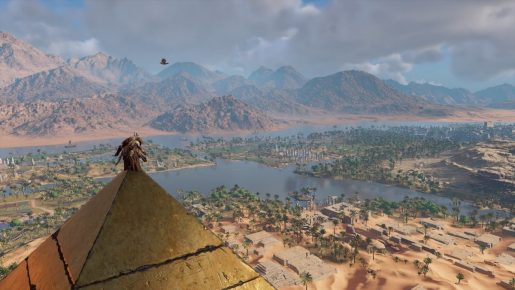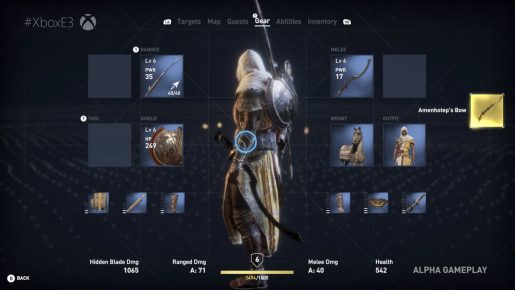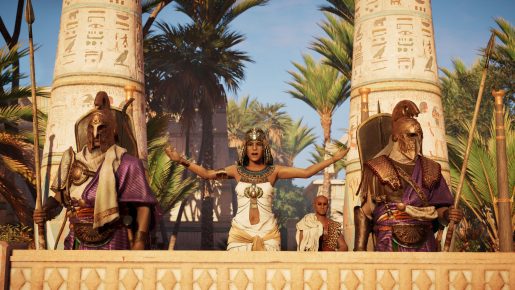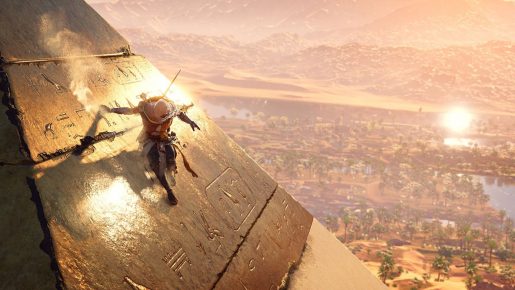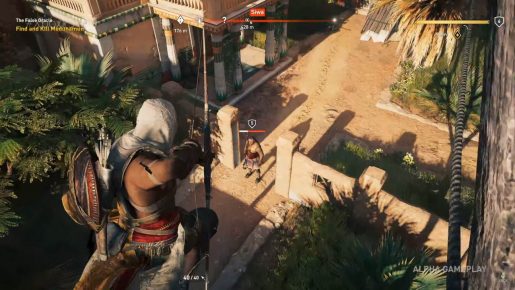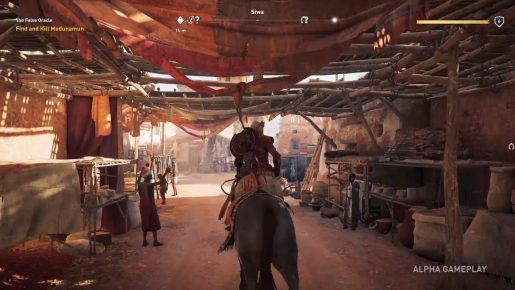Assassin’s Creed Origins is the brand-new action adventure game in the iconic, world famous, franchise from Ubisoft Montreal. After taking a year off from the previous yearly splurge of assassin based content the series is back with a vengeance. The extra development time seems to have paid off and a number of features elevate Assassin’s Creed Origins, taking the series to new heights.
Players take up the role of a Medjay, a sort of ancient Egyptian police force, named Bayek. Past the first 30 minutes, and after the Assassin’s Creed Origins logo has adorned the screen, the map opens up into a huge area for you to explore and see. I was fearful in this first half and hour we were in for another load of awkward Animus boundaries across the map cutting it into section. Thankfully, this is not the case and instead it is just to get you up to speed with Bayek. Without commenting on the plot of the storyline itself, to avoid giving even a minor spoiler away, this is a journey you’ll want to embark on. Even if you only utilize it as a way to know which location to navigate to next, otherwise there is so much choice on where to go it can almost be daunting.
A huge open and beautiful world is at Bayek’s feet ready for players to explore. Temples are dotted around the map with gorgeous vivid hieroglyphics decorating the walls and ornate pots and vases filling the rooms. These allow players to enter almost peaceful, quiet areas away from the hustle and bustle of the villages and city areas. The golden and orangey deserts rolling on, ready to be traversed until they lap at the waves of the Great Green Sea, the base of Giza pyramids and far beyond. This paragraph aims to capture some of the stunning imagery that this game produces. You are free to go as and where you please. The only limiting factor is the level of the enemies you might piss off in the areas along the way.
Limiting the map via level could send people two ways. Some will naturally be annoyed at the inability to do content in front of them. More likely is the case that it encourages players to stick around and do the content in areas, while not actually physically restricting them. By making players want to stay in an area they are more likely to enjoy the side quests. These are brilliant and build the strength of the lore of the locations, as Bayek attempts to help out the locals. Side quests play upon the thoughts and beliefs of the time period, as much as the main quest, to immerse gamers into the Egypt setting.
The levelling process doesn’t just apply to the AI that players come across, it also results in there being some rather dangerous animals roaming around the map. From crocodiles attacking civilians, which you can choose to help or not, to lions patrolling in the desert, certain animals can rain down some serious pain, or even Desynchronizations! You haven’t truly experienced Assassin’s Creed Origins until you have fled on a camel away from a fast-moving predator, only to run into some troops and be arrowed to death…
From Alexandria to the Pyramids you can, given the right vantage point, see the whole way. If not quickly using Senu, Bayek’s eagle, you can get a lay of the land without constantly bringing up the map. More impressive than the view is that players can make the journey loading free on foot, if you wish. Though taking a camel is a much better experience, due to the travel speed. Horses are available but you might as well get the full Egypt experience. It is hard to go from one place to another without being distracted by content along the way. Take the markets of the smaller settlements as an example. Wandering around them you can almost get lost in the weaving buildings and market stalls, coming across vendors of all kinds.
For those whom like to traverse the map and not just fast travel the Follow Road feature when on a camel or horse comes into its own. Simply set this feature and you can sit back and enjoy the journey, taking time to look around and take in the landscape. With this huge open map to cross this feature makes things a lot easier, though it isn’t always safest to follow every single road. Occasionally, bandits will be waiting for unsuspecting passers-by. Some Bayek will be able to dispatch with ease, others it is worth finding a route around.
The team has clearly had fun with the setting even including heat haze and mirages into the more desert areas. These all come with musical cues which harmoniously work into the background ambiance. Though they are noticeable none seem out of place from the setting allow the player to be emotionally driven whilst immersed in the game world. Tension can be increased, the pacing and tempo of missions can be ramped up and at times the mellowness can create a care-free feeling to exploration.
One noticeable difference between this and a lot of the previous Assassin’s Creed titles is the height aspects. Free running and climbing have always been a huge aspect of the franchise and this is no different in Assassin’s Creed Origins. Rather than endlessly dragging yourself up towering structures, for the most part, the built-up areas only have a few different heights. This maximises the fun free running gameplay elements, losing the repetitiveness of climbing, all while keeping the mixture of routes that are possible. Routes change height more than ever before something even noticeable in the huge city of Alexandria. This gives a sense of scale of the locations whilst limiting the repetitiveness that was constant vertical climbing.
The whole map isn’t made up of low-lying villages and Alexandria is a prime example of this. Yet, the same logic has been applied with paths zig-zagging through buildings of differing heights, up and down from one area to the next. This creates a world that towers over players and at the same time with only limited climbing can see the player able to look far into the distance over the top of huge portions of land. This is an incredible design feature that maximises the fun aspects of the free-running and this is something that really cannot be stressed enough, as it is a massive part of the franchise’s identity.
One thing that is new to the franchise are the combat mechanics that freshen up the ways the player will undoubtedly die. It does take a bit of time to get used to, resulting in a combat system that has killed me more than the previous handful of Assassin’s Creed games combined. Nevertheless, it is a change worth adapting to: adding even more flow to the fighting elements and adding in a touch more challenge.
It is worth it though as player will have to pick their fights more wisely and carefully. Enemies will still happily fire care free in your direction, regardless of whom could be in their line of fire. More so than ever players will be unable to just run in planning on taking on opponents in repetitive one on one fights to the death. This has been slowly improved as the number of Assassin’s Creed games released increased but the jump up to Origins combat system is instantly noticeable.
One of the UI elements which is extremely useful is an enemy level indicator. If an enemy vastly out levels you their level number becomes is a red shield. This indicates that they are levels above yours and might be worth sneaking around or turning back altogether. This shield becomes a skull on a red background if that unit can effectively insta-gib you. This isn’t an exaggeration I’ve had animals of multiple kinds, let alone AI troops on patrol, desynchronising me after accidentally confronting them.
The animations team has pulled no punches with some spectacular brutal takedowns. You know the game is serious when after spearing an enemy you let him slide down the shaft before pulling it out the other side. Brutal box: nicely ticked. While some of the regular takedowns are a tad weak in comparison the combo style button, after building up your adrenaline gauge, always portrays an awesome kill. It is often a satisfying end to a fight by the time you have built up the necessary adrenaline to perform one of these combo like devastating moves, so it is good that they do not disappoint.
Gamers have the ability more than ever to customise their gameplay experience via the huge choice of weapons. Within the starting half an hour, players will have earnt enough gold to buy a, albeit low level, weapon of most kinds. Fancy a slow pace hard hitting hammer, long reaching spear or pole arm or maybe just a trust sword the choice is up to you. The best bit if you find a weapon you like the look of is the Upgrade feature at the Blacksmiths found across the land. This enables players to upgrade their items to match their current rank, so these aren’t just there as a normal shop of goods. It isn’t cheap to regularly do but can be worth it if something cool is servery under levelled.
Furthering the customisation options is the perk tree. One decision early on players will need to make is whether to try to specialise early on down one route or fan out covering more bases. It’s handy for instance to pick up the ability to hold two melee weapons. So Bayek can equip a fast sword plus a big hitter. Though taking the slightly lame two bows option opens up the opportunity to get slow motion bow shots and even the ability to direct arrows mid-flight. Abilities like the slow-motion bow attacks while falling look incredible when they work, a caveat worth noting. It takes some practise for them to be remotely successful, let alone consistently headshot hitting. Grabbing a few skills here and there can make Bayek a better allrounder though you may not get some of the cooler abilities as early on without trying for them.
There have been numerous reports of issues running Assassin’s Creed Origins but I have nothing of the sort to report. To date it has run incredibly smoothly with no visible glitches, something that couldn’t be said about all previous Assassin’s Creed games at launch. I will admit I am running a fairly powerful rig packing an i7 and GTX 1080 (but it’s not the Ti version). From the render distances and the amount going on at times, with streets full of people, I can see it could punish lower end systems. Nonetheless, those at the other end of the spectrum should have no worries.
Another nicety for PC gamers is that it is not only possible to switch between controller and mouse and keyboard but it is easy. Start using whichever and the game picks up the latest input and switches any hints or controller UI aids over to the control scheme in use. So, you can flick back and forth between the two as you wish.
Slight niggle is with exiting the game. From inside the world players must Quit To Title Screen. Rather than then simply being able to quit you must press any button, where the game checks what additional content you have, before finally being able to press Quit To Desktop. Why this is not an option from within the game baffles me: it would be the case of including an additional option. This is especially baffling to me as I have never found the need, or want, to only quit to the title screen, I’m either continuing to play or needing to completely stop.
Another minor issue is one that has been ever present in Assassin’s Creed games since the very first. When riding a horse, or camel, along open plains the animations work fine. As soon as a player takes a ride along an evenly sparsely populated road and bumping into things soon becomes a bit immersion breaking. This issue is only compounded further when it comes to the awkwardness of the jumping, of these animals, over low walls. The speeds bursts seem unnaturally forced in. I understand this has been done to make sure players don’t get stuck, I just hoped by now they would have come up with a more visually acceptable way around the problem.
So, there are a few tiny issues I have with Assassin’s Creed Origins, yet, I would still say this beats the likes of Black Flag to win the title as the best game of the franchise. A bold claim for such a loved franchise, especially one with so many games in it. It takes so many concepts of the previous games such as the free-running and plays to their strengths whilst minimising their weaknesses to great effect. Yes, the new combat system takes a little bit of getting used to but it is well worth it.
Verdict
 Egypt is perhaps the perfect choice as it is so different to what has come recently from the series making the experience feel even fresher. The vibrancy of spice markets, rich blues of the water colour and a decent mixture of some lush green sections, cut smoothly through the golden orangey desert. The ancient Egyptian time period is shown in all its glory across a beautiful map: from the dark caverns and squalor ridden outer reaches to the affluent Alexandria and slide-able pyramids Assassin’s Creed Origins has it all. Taking a year off from releasing an instalment has comfortably paid off for Ubisoft who have a real Game of the Year contender on their hands.
Egypt is perhaps the perfect choice as it is so different to what has come recently from the series making the experience feel even fresher. The vibrancy of spice markets, rich blues of the water colour and a decent mixture of some lush green sections, cut smoothly through the golden orangey desert. The ancient Egyptian time period is shown in all its glory across a beautiful map: from the dark caverns and squalor ridden outer reaches to the affluent Alexandria and slide-able pyramids Assassin’s Creed Origins has it all. Taking a year off from releasing an instalment has comfortably paid off for Ubisoft who have a real Game of the Year contender on their hands.
[Editor’s Note: Assassin’s Creed Origins was reviewed on PC and PS4, the game was provided to us for the review.]

